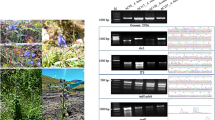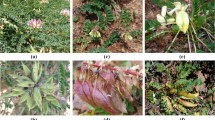Abstract
Background
Aconitum heterophyllum Wall. ex Royle and Aconitum balfourii Stapf, are two highly important, threatened medicinal plants of the Indian Himalayan Region. Root-tubers of Aconites have occupied an important place in Indian pharmacopoeia from very ancient times. India is a hub of the wild-collected medicinal herbs industry in Asia and these two aconites are known to have been heavily traded from the region in illicit manner. Prosecution of these illegal trading crimes is hampered by lack of pharma-forensic expertise and tools.
Methods and results
Present study was conducted to evaluate the discriminatory potential of rbcL, a Chloroplast based DNA barcode marker for the authentication of these two Himalayan Aconites. Fresh plant samples were collected from their natural distributional range as well as raw materials were procured from herbal market and a total of 32 sequences were generated for the rbcL region. Analysis demonstrated that rbcL region can successfully be used for authentication and importantly, both the aconites, were successfully discriminated by rbcL locus with high bootstrap support (> 50%).
Conclusion
Molecular markers could certainly be relied upon morphological and chemical markers being tissue specific, having a higher discriminatory power and not age dependent. Phylogenetic analysis using Maximum Likelihood Method revealed that the rbcL gene could successfully discriminate Himalayan Aconites to species level and have potential to be used in pharma-forensic applications as well as to curb illicit trade of these invaluable medicinal plants.




Similar content being viewed by others
Data Availability
The sequence data is available in NCBI GenBank.
References
Chaudhary L, Rao R (1998) Notes on the genus Aconitum L. (Ranunculaceae) in North-West Himalaya (India). Feddes Repertorium 109(7–8):527–537. https://doi.org/10.1002/fedr.19981090708
Stapf O (1905) The aconites of India: a monograph. Ann Roy Bot Gard Calcutta 10(2):161
POWO (2017) Kew Science Plants of the World online http://www.plantsoftheworldonline.org/. Accessed 19 January 2021
Singh B, Chauhan R, Vashistha R, Nautiyal M, Prasad P (2012) Ecological features of Aconitum balfourii (Bruhl) Muk - an endangered medicinal plant in the northwest Himalaya. J Forestry Res 23(1):145–150. https://doi.org/10.1007/s11676-012-0245
Agnihotri P, Husain D, Husain T (2015) Assessment of diversity, endemism and distribution of the genus Aconitum Linnaeus (Ranunculaceae) in India. Pleione 9(1):95–102
Chakrabarti L, Varshney V (2001) Trading in contraband. Down to Earth 9: 27–41.https://www.downtoearth.org.in/coverage/trading-in-contraband--38700
Ji Y, Liu C, Yang J, Jin L, Yang Z, Yang J (2020) Ultra-barcoding discovers a cryptic species in Paris yunnanensis (Melanthiaceae), a medicinally important plant. Front Plant Sci 11:411. https://doi.org/10.3389/fpls.2020.00411
Bell D, Long DG, Forrest AD, Hollingsworth ML, Blom HH, Hollingsworth P (2012) DNA barcoding of European Herbertus (Marchantiopsida, Herbertaceae) and the discovery and description of a new species. Mol Ecol Resour 12(1):36–47. https://doi.org/10.1111/j.1755-0998.2011.03053.x
Heckenhauer J, Abu Salim K, Chase MW, Dexter KG, Pennington RT, Tan S, Kaye ME, Samuel R (2017) Plant DNA barcodes and assessment of phylogenetic community structure of a tropical mixed dipterocarp forest in Brunei Darussalam (Borneo). PLoS ONE 12(10):e0185861. https://doi.org/10.1371/journal.pone.0185861
Kim HM, Oh SH, Bhandari GS, Kim CS, Park CW (2014) DNA barcoding of Orchidaceae in Korea. Mol Ecol Resour 14(3):499–507. https://doi.org/10.1111/1755-0998.12207
Gere J, Yessoufou K, Daru BH, Mankga L, Maurin O, van der Bank M (2013) Incorporating trnH-psbA to the core DNA barcodes improves significantly species discrimination within southern African Combretaceae. ZooKeys 365(1):129–147. https://doi.org/10.3897/zookeys.365.5728
Rajaram MC, Yong CSY, Gansau JA, Go R (2019) DNA barcoding of endangered Paphiopedilum species (Orchidaceae) of Peninsular Malaysia. Phytotaxa 387(2):94–104. https://doi.org/10.11646/phytotaxa.387.2.2
Gogoi B, Bhau BS (2018) DNA barcoding of the genus Nepenthes (Pitcher plant): a preliminary assessment towards its identification. BMC Plant Biol 18(1):153. https://doi.org/10.1186/s12870-018-1375-5
Lahaye R, van der Bank M, Bogarin D, Warner J, Pupulin F, Gigot G, Savolainen V (2008) DNA barcoding the floras of biodiversity hotspots. PNAS 105:2923–2928
Liu M, Li XW, Liao BS, Luo L, Ren YY (2019) Species identification of poisonous medicinal plant using DNA barcoding. Chin J Nat Med 17(8):585–590. https://doi.org/10.1016/s1875-5364(19)30060-3
Malik S, Priya A, Babbar S (2018) Employing barcoding markers to authenticate selected endangered medicinal plants traded in Indian markets. Physiol Mol Biol Plants 25:327–337. https://doi.org/10.1007/s12298-018-0610-8
Udhayasankar M, Vaishnavi M, Sowmiya K, Gajalalakshmi R, Chandra Mohan A (2017) DNA Barcode of Indian Medicinal Plant Anethum Graveolens L by MatK Gene. Int j res appl sci eng technol 5(7): 670- 676. https://www.ijraset.com/fileserve.php?FID=8856
Little D (2014) Authentication of Ginkgo biloba herbal dietary supplements using DNA barcoding. Genome 57(9):513–516. https://doi.org/10.1139/gen-2014-0130
Mahadani P, Ghosh SK (2013) DNA Barcoding: A tool for species identification from herbal juices. DNA Barcodes. https://doi.org/10.2478/dna-2013-0002
Newmaster S, Grguric M, Shanmughanandhan D, Ramalingam S, Ragupathy S (2013) DNA barcoding detects contamination and substitution in North American herbal products. BMC Med 11:222. https://doi.org/10.1186/1741-7015-11-222
Seethapathy GS, Ganesh D, Kumar JUS, Senthilkumar U, Newmaster SG, Ragupathy S, Shaanker RU, Ravikanth G (2014) Assessing product adulteration in natural health products for laxative yielding plants, Cassia, Senna, and Chamaecrista, in Southern India using DNA barcoding. Int J Legal Med 129(4):693–700. https://doi.org/10.1007/s00414-014-1120-z
He T, Jiao L, Yu M, Guo J, Jiang X, Yin Y (2018) DNA barcoding authentication for the wood of eight endangered Dalbergia timber species using machine learning approaches. Holzforschung 73(3):277–285. https://doi.org/10.1515/hf-2018-0076
Yu M, Jiao L, Guo J, Wiedenhoeft AC, He T, Jiang X, Yin Y (2017) DNA barcoding of vouchered xylarium wood specimens of nine endangered Dalbergia species. Planta 246(6):1165–1176. https://doi.org/10.1007/s00425-017-2758-9
Dev SA, Muralidharan EM, Sujanapal P, Balasundaran M (2014) Identification of market adulterants in East Indian sandalwood using DNA barcoding. Ann For Sci 71:517–522. https://doi.org/10.1007/s13595-013-0354-0
Hebert P, Cywinska A, Ball S, deWaard J (2003) Biological identifications through DNA barcodes. Proc R Soc B 270:313–321
CBOL (2009) A DNA barcode for land plants. PNAS 106:12794–12797. https://doi.org/10.1073/pnas.0905845106
Zhou J, Wang W, Liu M, Liu Z (2014) Molecular authentication of the traditional medicinal plant Peucedanum praeruptorum and its substitutes and adulterants by DNA-barcoding technique. Phcog Mag 10:385–390. https://doi.org/10.4103/0973-1296.141754
Chandramohan A, Divya SR, Dhanarajan MS (2013) MatK gene-based molecular characterization of medicinal plant-Croton bonplandianum Baill. Int J Biosci Res 2:1–7
Parvathy VA, Swetha VP, Sheeja TE, Leela NK, Chempakam B, Sasikumar B (2014) DNA barcoding to detect chilli adulteration in traded Black pepper powder. Food Biotechnol 28(1):25–40. https://doi.org/10.1080/08905436.2013.870078
Wu CT, Hsieh CC, Lin WC, Tang CY, Yang CH, Huang YC, Ko YJ (2013) Internal transcribed spacer sequencebased identification and phylogenic relationship of I-Tiao-Gung originating from Flemingia and Glycine (Leguminosae) in Taiwan. J Food Drug Anal 21:356–362. https://doi.org/10.1016/j.jfda.2013.08.002
Al-Qurainy F, Khan S, Tarroum M, Al-Hemaid FM, Ali MA (2011) Molecular authentication of the medicinal herb Ruta graveolens (Rutaceae) and an adulterant using nuclear and chloroplast DNA markers. Genet Mol Res 10(4):2806–2816. https://doi.org/10.4238/2011.November.10.3
Chase MW, Cowan RS, Hollingsworth PM, van den Berg C, Madrinan S, Petersen G, Seberg O, Jorgsensen T, Cameron KM, Carine M, Pedersen N, Hedderson TAJ, Conrad F, Salazar GA, Richardson JE, Hollingsworth ML, Barraclough TG, Kelly L, Wilkinson M (2007) A proposal for a standardized protocol to barcode all land plants. Taxon 56:295–299. https://doi.org/10.1002/tax.562004
Kress W, Wurdack K, Zimmer E, Weigt L, Janzen D (2005) Use of DNA barcodes to identify flowering plants. Proceedings of the National Academy of Sciences USA 102:8369–8374
Singh H, Parveen I, Raghuvanshi S, Babbar S (2012) The loci recommended as universal barcodes for plants on the basis of floristic studies may not work with congeneric species as exemplified by DNA barcoding of Dendrobium species. BMC Res Notes 5:4. https://doi.org/10.1186/1756-0500-5-42
Parveen I, Singh H, Raghuvanshi S, Pradhan U, Babbar S (2012) DNA barcoding of endangered Indian Paphiopedilum species. Mol Ecol Resour 12:82–90. https://doi.org/10.1111/j.1755-0998.2011.03071.x
Swetha V, Parvathy V, Sheeja T, Sasikumar B (2017) Authentication of Myristica fragrans Houtt. using DNA barcoding. Food Control 73:1010–1015. https://doi.org/10.1016/j.foodcont.2016.10.004
Dayanandan S, Bawa K, Kesseli R (1997) Conservation of microsatellites among tropical trees (leguminosae). Am J Bot 84(12):1658–1663. https://doi.org/10.2307/2446463
Hall T (1999) BioEDIT: a user friendly biological sequence allignment editor and analysis programme for Windows 95/98/NT. Nucleic Acids Symp Ser 41:95–98
Kumar S, Stecher G, Li M, Knyaz C, Tamura K (2018) MEGA X: molecular evolutionary genetics analysis across computing platforms. Mol Biol Evol 35:1547–1549. https://doi.org/10.1093/molbev/msy096
Librado P, Rozas J (2009) DnaSP v5: a software for comprehensive analysis of DNA polymorphism data. Bioinformatics 25:1451–1452. https://doi.org/10.1093/bioinformatics/btp187
Rozas J (2009) DNA Sequence polymorphism analysis using DnaSP Bioinformatics for DNA sequence analysis. Methods Mol Biol Series 537:337–350. https://doi.org/10.1007/978-1-59745-251-9_17
Kimura M (1980) A simple method for estimating evolutionary rates of base substitutions through comparative studies of nucleotide sequences. J Mo Evol 16:111–120
Felsenstein J (1981) Evolutionary trees from DNA sequences: A maximum likelihood approach. J Mol Evol 17(6):368–376. https://doi.org/10.1007/bf01734359
Tamura K (1992) Estimation of the number of nucleotide substitutions when there are strong transition-transversion and G + C-content biases. Mol Biol Evol 9:678–687
Felsenstein J (1985) Confidence limits on phylogenies: An approach using the bootstrap. Evolution 39:783–791
DeSalle R, Egan M, Siddall M (2005) The unholy trinity: taxonomy, species delimitation and DNA barcoding. Philos Trans R Soc Lond B Biol Sci 360:1905–1916. https://doi.org/10.1098/rstb.2005.1722
Pettengill J, Neel M (2010) An evaluation of candidate plant DNA barcodes and assignment methods in diagnosing 29 species in the genus Agalinis (Orobanchaceae). Am J Bot 97:1391–1406. https://doi.org/10.3732/ajb.0900176
Hosein F, Austin N, Maharaj S, Johnson W, Rostant L, Ramdass A, Rampersad S (2017) Utility of DNA barcoding to identify rare endemic vascular plant species in Trinidad. Ecol Evol 7(18):7311–7333. https://doi.org/10.1002/ece3.3220
Meena R, Negi N, Uniyal N, Shamoon A, Bhandari M, Pandey S, Negi RK, Sharma S, Ginwal H (2020) Chloroplast-based DNA barcode analysis indicates high discriminatory potential of matK locus in Himalayan temperate bamboos. 3Biotech 10:534. https://doi.org/10.1007/s13205-020-02508-7
He J, Yao M, Lyu R, Lin L, Liu H, Pei L, Yan S, Xie L, Cheng J (2019) Structural variation of the complete chloroplast genome and plastid phylogenomics of the genus Asteropyrum (Ranunculaceae). Sci Rep 9:15285. https://doi.org/10.1038/s41598-019-51601-2
Acknowledgements
The work was financially supported by Indian Council of Forestry Research and Education (ICFRE), Dehradun as a research project [FRI-619/Bot-81]. We thank to the Director Forest Research Institute, Dehradun for providing facility for laboratory and field works. The forest department of Uttarakhand, India also duly acknowledged for their assistance and permissions in surveys and sample collection from the forest area under their jurisdiction.
Funding
The work was financially supported by Indian Council of Forestry Research and Education (ICFRE) as research Project [FRI-619/Bot-81].
Author information
Authors and Affiliations
Contributions
RKN involved in project conceptualization, execution and manuscript writing; PN and R conducted the laboratory work; RKN and PN carried out sequence data analysis; R and RV conducted field visits for sample collection.
Corresponding author
Ethics declarations
Conflict of interest
On behalf of all authors, the corresponding author states that there is no conflict of interest.
Ethical approval
All necessary permissions were obtained for sample collection from concerned state forest department. Individuals in the photographs gave their permission for the photos to be published.
Consent to participate
All authors agreed to participate for submission of the research to the journal.
Consent for publication
All the authors have approved the manuscript for submission and publication in journal.
Additional information
Publisher's Note
Springer Nature remains neutral with regard to jurisdictional claims in published maps and institutional affiliations.
Supplementary Information
Below is the link to the electronic supplementary material.
Rights and permissions
About this article
Cite this article
Negi, R.K., Nautiyal, P., Bhatia, R. et al. rbcL, a potential candidate DNA barcode loci for aconites: conservation of himalayan aconites. Mol Biol Rep 48, 6769–6777 (2021). https://doi.org/10.1007/s11033-021-06675-5
Received:
Accepted:
Published:
Issue Date:
DOI: https://doi.org/10.1007/s11033-021-06675-5




